Copia y pega el siguiente código en tu proyecto de Python para generar una gráfica SVG con estilo personalizado.
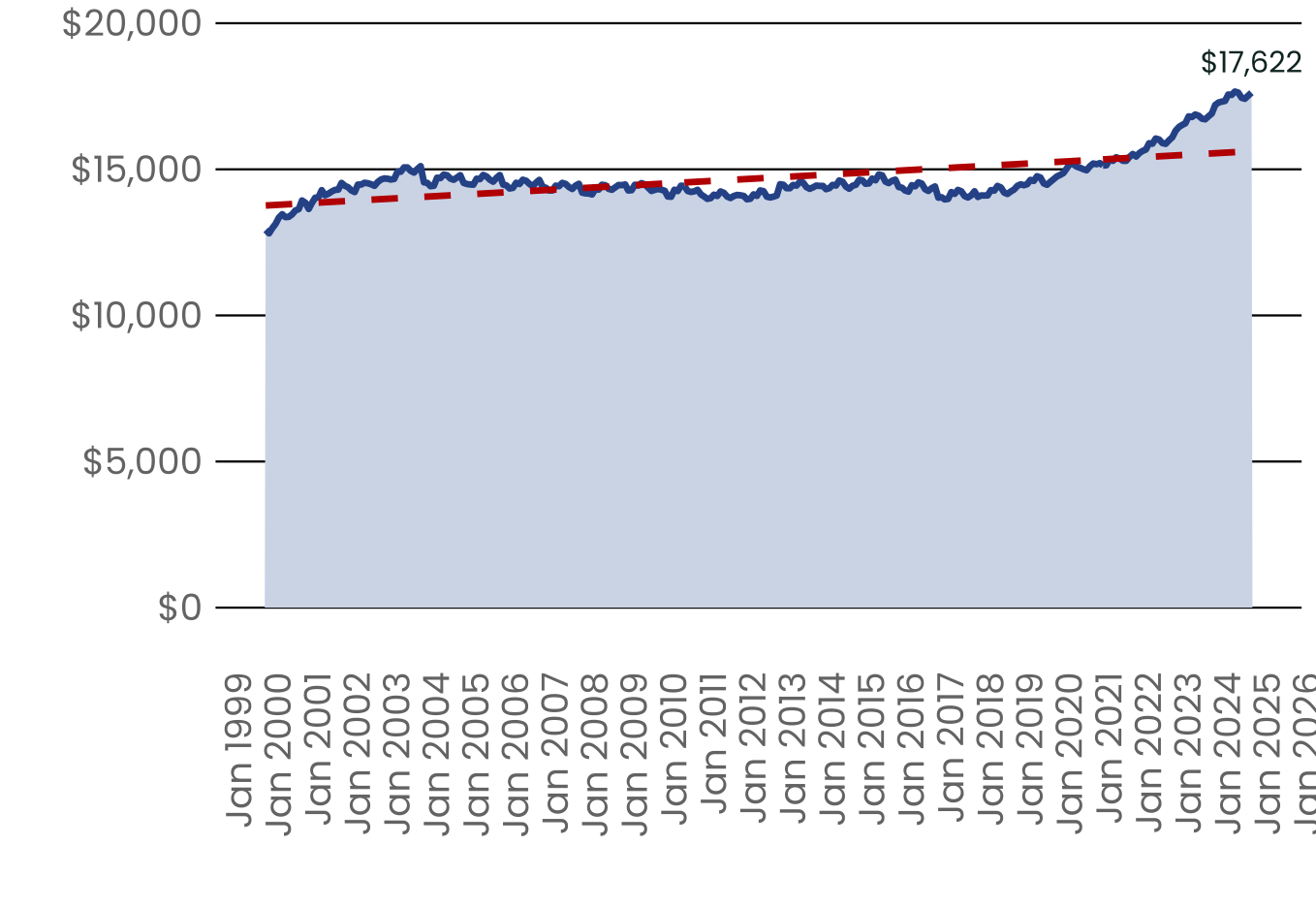
# Colores estilo Python
color_area <- "#d4dce9" # área azul claro
color_linea <- "#2f5597" # línea principal
color_tendencia <- "#c00000" # línea punteada roja
# Fuente
font_add_google("Poppins", "Poppins")
showtext_auto()
# Tema adaptado estilo matplotlib institucional
tema_python_atdt <- function() {
theme_minimal(base_family = "Poppins") +
theme(
plot.title = element_text(size = 14, face = "bold", color = "black"),
axis.text = element_text(size = 10, color = "#767676"),
axis.title = element_text(size = 10, face = "bold", color = "#000000"),
axis.text.x = element_text(angle = 90, hjust = 1),
panel.grid.major.x = element_blank(),
panel.grid.minor = element_blank(),
panel.grid.major.y = element_line(color = "#000000", linewidth = 0.4, linetype = "solid"),
axis.ticks = element_blank(),
legend.position = "none",
plot.background = element_rect(fill = "transparent", color = NA),
panel.background = element_rect(fill = "transparent", color = NA)
)
}
# Crear gráfica
ggplot(datos, aes(x = fecha, y = total_def)) +
geom_area(fill = color_area, alpha = 1) +
geom_line(color = color_linea, linewidth = 1.2) +
geom_line(aes(y = tendencia), color = color_tendencia, linewidth = 1.2, linetype = "dashed") +
geom_text(
data = tail(datos, 1),
aes(label = scales::dollar(total_def)),
hjust = 0.5, vjust = -1,
family = "Poppins", size = 4, color = "#10302C"
) +
scale_x_date(date_labels = "%b %Y",
date_breaks = "1 year")+
scale_y_continuous(labels = dollar_format(), expand = expansion(mult = c(0.1, 0.15))) +
labs(
x = NULL,
y = NULL
) +
tema_python_atdt()
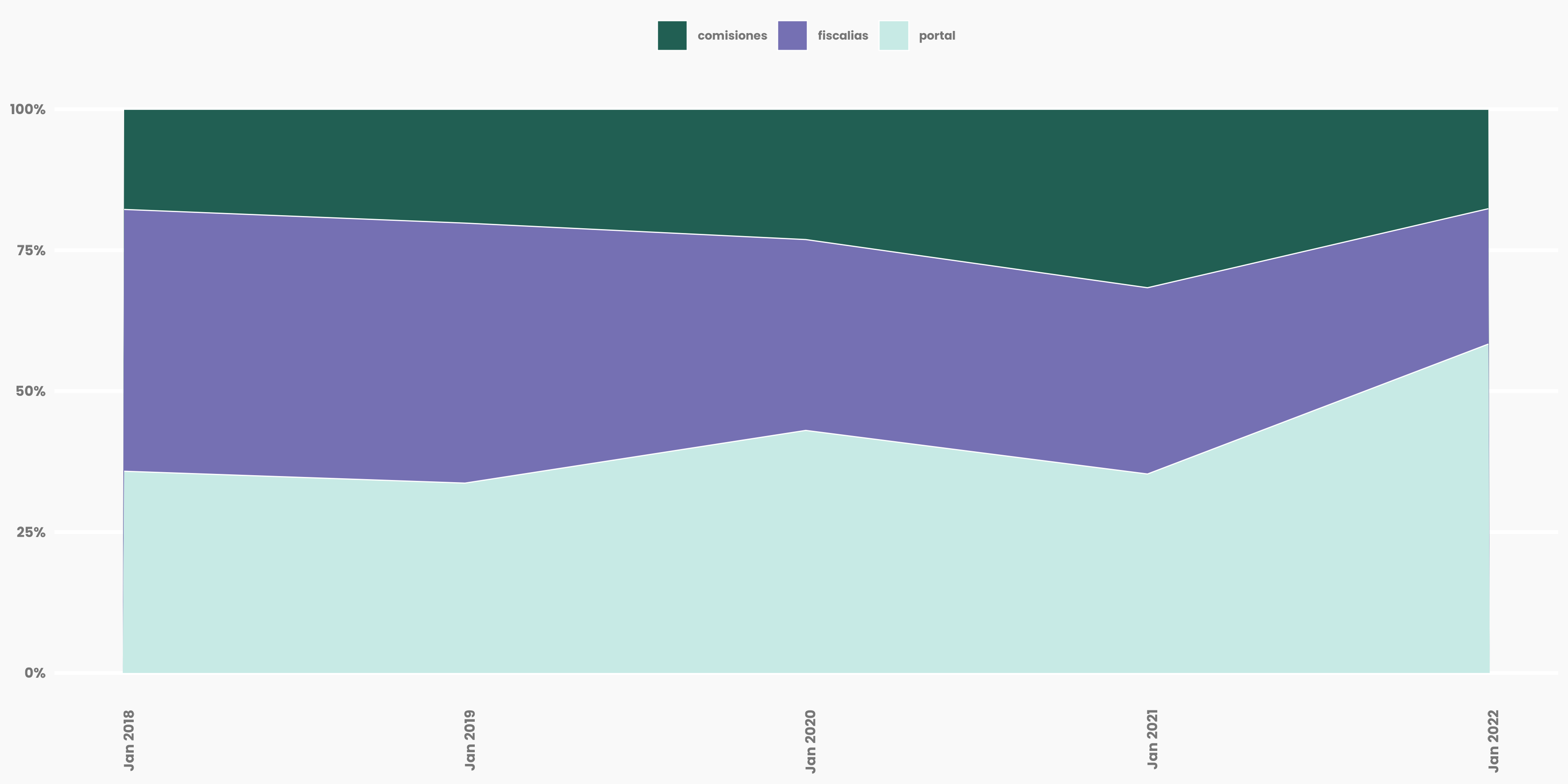
# Colores arbitrarios sin nombres
colores <- c("#215F53", "#7570B3", "#C7EAE5")
# Gráfico
ggplot(df, aes(x = fecha, y = valor, fill = fuente)) +
geom_area(position = "stack", color = "white", linewidth = 0.4) +
scale_fill_manual(values = colores) +
scale_y_continuous(labels = percent_format()) +
theme_minimal() +
theme(
legend.position = "top",
legend.title = element_blank()
)

# Paleta fija para las categorías
colores <- c(
"Hombre" = "#4C6A67",
"Mujer" = "#627B78",
"No identificado" = "#6F8583"
)
blanco <- "white"
# Tema ATDT
tema_python_atdt <- function() {
theme_minimal() +
theme(
plot.title = element_text(size = 14, face = "bold", color = "black"),
axis.text = element_text(size = 10, color = "#767676"),
axis.title = element_text(size = 10, face = "bold", color = "#000000"),
axis.text.x = element_text(angle = 90, hjust = 1),
panel.grid.major.x = element_blank(),
panel.grid.minor = element_blank(),
panel.grid.major.y = element_line(color = "#000000", linewidth = 0.4),
axis.ticks = element_blank(),
legend.position = "top",
plot.background = element_rect(fill = "transparent", color = NA),
panel.background = element_rect(fill = "transparent", color = NA)
)
}
# Gráfica
ggplot(datos, aes(x = fecha, y = valor, fill = categoria)) +
geom_col(position = "stack", width = 20) +
scale_fill_manual(values = colores) +
scale_x_date(
date_labels = "%b %Y",
date_breaks = "1 month",
expand = expansion(mult = c(0.01, 0.01))
) +
scale_y_continuous(
expand = expansion(mult = c(0, 0.1))
) +
labs(x = "", y = "") +
tema_python_atdt()

# Paleta fija para las categorías
colores <- c(
"Hombre" = "#4C6A67",
"Mujer" = "#627B78",
"No identificado" = "#6F8583"
)
blanco <- "white"
# Tema ATDT
tema_python_atdt <- function() {
theme_minimal() +
theme(
plot.title = element_text(size = 14, face = "bold", color = "black"),
axis.text = element_text(size = 10, color = "#767676"),
axis.title = element_text(size = 10, face = "bold", color = "#000000"),
axis.text.x = element_text(angle = 90, hjust = 1),
panel.grid.major.x = element_blank(),
panel.grid.minor = element_blank(),
panel.grid.major.y = element_line(color = "#000000", linewidth = 0.4),
axis.ticks = element_blank(),
legend.position = "top",
plot.background = element_rect(fill = "transparent", color = NA),
panel.background = element_rect(fill = "transparent", color = NA)
)
}
# Simular datos apilables
set.seed(123)
fechas <- seq(as.Date("2023-01-01"), as.Date("2023-12-01"), by = "month")
categorias <- c("Hombre", "Mujer", "No identificado")
datos <- expand.grid(fecha = fechas, categoria = categorias) %>%
mutate(valor = round(runif(n(), 2000, 5000)))
# Gráfica
ggplot(datos, aes(x = fecha, y = valor, fill = categoria)) +
geom_col(position = "stack", width = 20) +
scale_fill_manual(values = colores) +
scale_x_date(
date_labels = "%b %Y",
date_breaks = "1 month",
expand = expansion(mult = c(0.01, 0.01))
) +
scale_y_continuous(
expand = expansion(mult = c(0, 0.1))
) +
labs(x = "", y = "") +
tema_python_atdt() + # primero tu tema base
theme( # luego ajustes adicionales
axis.text.x = element_blank(),
panel.grid.major.y = element_blank(),
panel.grid.minor.y = element_blank()
) +
coord_flip()

# Paleta de color
verde_base <- "#10302C"
rojo_maximo <- "#8B0000"
blanco <- "white"
#fonts
font_add("Poppins", "/Users/tabatagarcia/Desktop/plantillas/python/agrupadasyapiladas/fonts/poppins/Poppins-Regular.ttf")
showtext_auto()
tema_python_atdt <- function() {
theme_minimal(base_family = "Poppins") +
theme(
plot.title = element_text(size = 14, face = "bold", color = "black"),
axis.text = element_text(size = 10, color = "#767676"),
axis.title = element_text(size = 10, face = "bold", color = "#000000"),
axis.text.x = element_text(angle = 90, hjust = 1),
panel.grid.major.x = element_blank(),
panel.grid.minor = element_blank(),
panel.grid.major.y = element_line(color = "#000000", linewidth = 0.4, linetype = "solid"),
axis.ticks = element_blank(),
legend.position = "none",
plot.background = element_rect(fill = "transparent", color = NA),
panel.background = element_rect(fill = "transparent", color = NA)
)
}
grafica <- ggplot(datos, aes(x = fecha, y = total_def)) +
geom_col(aes(fill = color_barra), width = 20, show.legend = FALSE) +
geom_label(aes(y = y_label, label = etiqueta, fill = color_badge),
color = blanco,
family = "Poppins",
size = 3.5,
label.size = 0,
angle = 90,
label.r = unit(6, "pt"),
hjust = 1,
vjust = 0.45,
show.legend = FALSE) +
scale_fill_identity() +
scale_x_date(
date_labels = "%b %Y",
date_breaks = "1 month",
expand = expansion(mult = c(0.01, 0.01))
) +
scale_y_continuous(
labels = scales::dollar_format(),
expand = expansion(mult = c(0, 0.2))
) +
tema_python_atdt() +
theme(axis.title.x = element_blank(), axis.title.y = element_blank())

# Paleta de color
verde_base <- "#10302C"
rojo_maximo <- "#8B0000"
blanco <- "white"
#fonts
font_add("Poppins", "/Users/tabatagarcia/Desktop/plantillas/python/agrupadasyapiladas/fonts/poppins/Poppins-Regular.ttf")
showtext_auto()
tema_python_atdt <- function() {
theme_minimal(base_family = "Poppins") +
theme(
plot.title = element_text(size = 14, face = "bold", color = "black"),
axis.text = element_text(size = 10, color = "#767676"),
axis.title = element_text(size = 10, face = "bold", color = "#000000"),
axis.text.x = element_text(angle = 90, hjust = 1),
panel.grid.major.x = element_blank(),
panel.grid.minor = element_blank(),
panel.grid.major.y = element_line(color = "#000000", linewidth = 0.4, linetite = "solid"),
axis.ticks = element_blank(),
legend.position = "none",
plot.background = element_rect(fill = "transparent", color = NA),
panel.background = element_rect(fill = "transparent", color = NA)
)
}
grafica <- ggplot(datos, aes(x = fecha, y = total_def)) +
geom_col(aes(fill = color_barra), width = 20, show.legend = FALSE) +
geom_label(aes(y = y_label, label = etiqueta, fill = color_badge),
color = blanco,
family = "Poppins",
size = 3.5,
label.size = 0,
angle = 0,
label.r = unit(6, "pt"),
hjust = 1,
vjust = 0.45,
show.legend = FALSE) +
scale_fill_identity() +
scale_x_date(
date_labels = "%b %Y",
date_breaks = "1 month",
expand = expansion(mult = c(0.01, 0.01))
) +
scale_y_continuous(
labels = scales::dollar_format(),
expand = expansion(mult = c(0, 0.2))
) +
tema_python_atdt() +
theme(axis.title.x = element_blank(), axis.title.y = element_blank(),
axis.text.x = element_blank(),
panel.grid.major.y = element_blank()) +
coord_flip()
# Tema personalizado
theme_personalizado <- theme_minimal(base_size = 12) +
theme(
plot.title = element_text(face = "bold"),
axis.text.x = element_text(angle = 90, hjust = 1, size = 6),
axis.text.y = element_text(size = 6),
axis.title = element_text(size = 10),
panel.border = element_rect(color = "gray20", fill = NA, linewidth = 0.5),
axis.ticks = element_blank(),
panel.grid = element_blank(),
legend.position = "right"
)
# Crear gráfica
grafica <- ggplot(datos_sum, aes(x = mes, y = valor, fill = indicador)) +
geom_col(position = "stack", width = 30) +
scale_fill_manual(values = c("Con datos" = "#584290", "Sin datos" = "#b1adcf")) +
labs(
title = "Ejemplo de gráfica de barras apiladas",
x = "Fecha",
y = "Número de casos",
fill = NULL
) +
scale_x_date(date_breaks = "2 years", date_labels = "%Y") +
theme_personalizado
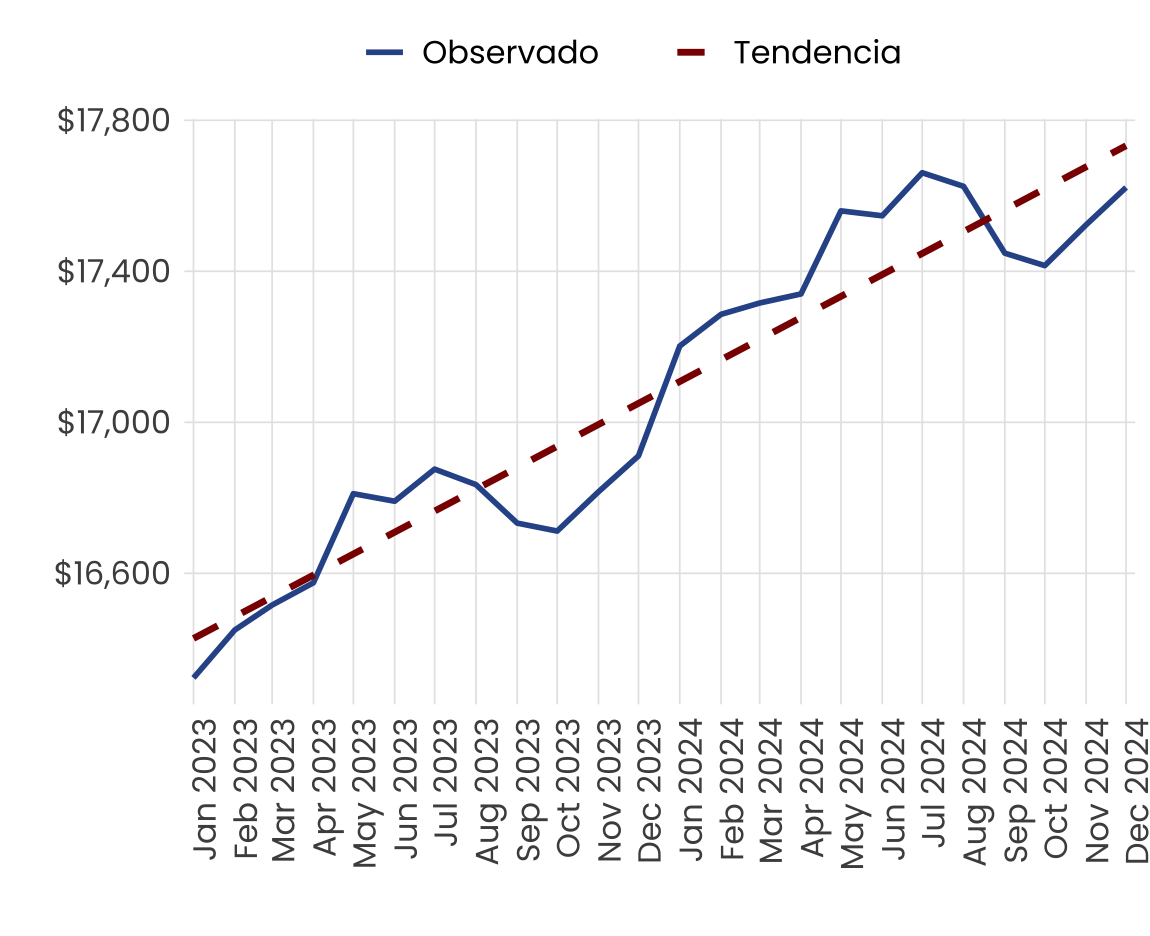
# Colores estilo limpio
verde_base <- "#10302C"
rojo_maximo <- "#8B0000"
blanco <- "white"
azul_linea <- "#2F5597"
naranja_linea <- "#D55E00"
# Tema visual tipo matplotlib limpio
tema_estilo_multilinea <- function() {
theme_minimal(base_family = "Poppins") +
theme(
plot.title = element_text(size = 14, face = "bold", color = "black"),
axis.text = element_text(size = 10, color = "#4D4D4D"),
axis.title = element_blank(),
axis.text.x = element_text(angle = 90, hjust = 1),
panel.grid.major = element_line(color = "#E5E5E5", linewidth = 0.3),
panel.grid.minor = element_blank(),
panel.background = element_rect(fill = "white", color = NA),
plot.background = element_rect(fill = "white", color = NA),
legend.position = "top",
legend.title = element_blank(),
legend.text = element_text(size = 10),
axis.ticks = element_blank()
)
}
# Gráfica
grafica <- ggplot(datos, aes(x = fecha)) +
geom_line(aes(y = total_def, color = "Observado"), linewidth = 1) +
geom_line(aes(y = tendencia, color = "Tendencia"), linewidth = 1.2, linetype = "dashed") +
geom_hline(yintercept = 0, color = "gray30", linewidth = 0.4) +
scale_color_manual(values = c("Observado" = azul_linea, "Tendencia" = rojo_maximo)) +
scale_x_date(date_labels = "%b %Y", date_breaks = "1 month", expand = expansion(mult = c(0.01, 0.01))) +
scale_y_continuous(labels = dollar_format()) +
tema_estilo_multilinea()
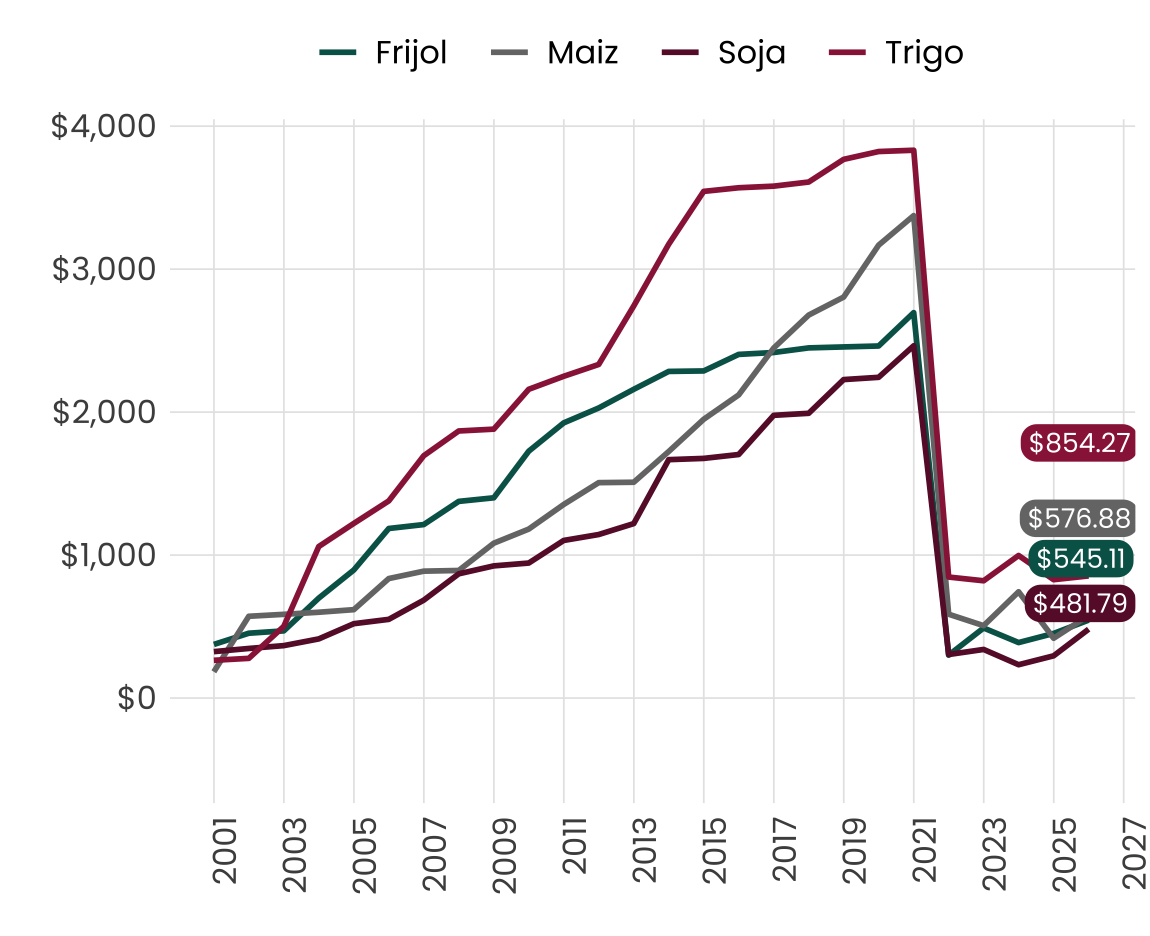
# Colores y tema
colores <- c("#006157", "#767676", "#671435", "#9B2247")
blanco <- "white"
# Últimos puntos para badge
etiquetas <- df_largo %>%
group_by(variable) %>%
filter(Fecha == max(Fecha)) %>%
mutate(etiqueta = scales::dollar(valor))
# Crear badges bien distribuidos verticalmente
etiquetas <- df_largo %>%
group_by(variable) %>%
filter(Fecha == max(Fecha)) %>%
ungroup() %>%
arrange(desc(valor)) %>% # ordenar globalmente por valor
mutate(
etiqueta = scales::dollar(valor),
x_label = Fecha + lubridate::days(30), # desplazar a la derecha
y_label = valor + row_number() * -250 # separar verticalmente
)
# Gráfica
ggplot(df_largo, aes(x = Fecha, y = valor, color = variable)) +
geom_line(linewidth = 1) +
geom_hline(yintercept = 0, color = "gray30", linewidth = 0.4) +
scale_color_manual(values = colores) +
geom_label(data = etiquetas,
aes(x = x_label, y = y_label, label = etiqueta, fill = variable),
color = blanco,
family = "Poppins",
size = 3.5,
label.size = 0,
label.r = unit(6, "pt"),
hjust = 0.6,
vjust = -4,
show.legend = FALSE) +
scale_fill_manual(values = colores) +
scale_y_continuous(labels = scales::dollar_format()) +
scale_x_date(date_labels = "%Y", date_breaks = "2 year") +
tema_estilo_multilinea() +
theme(axis.title.x = element_blank(), axis.title.y = element_blank())
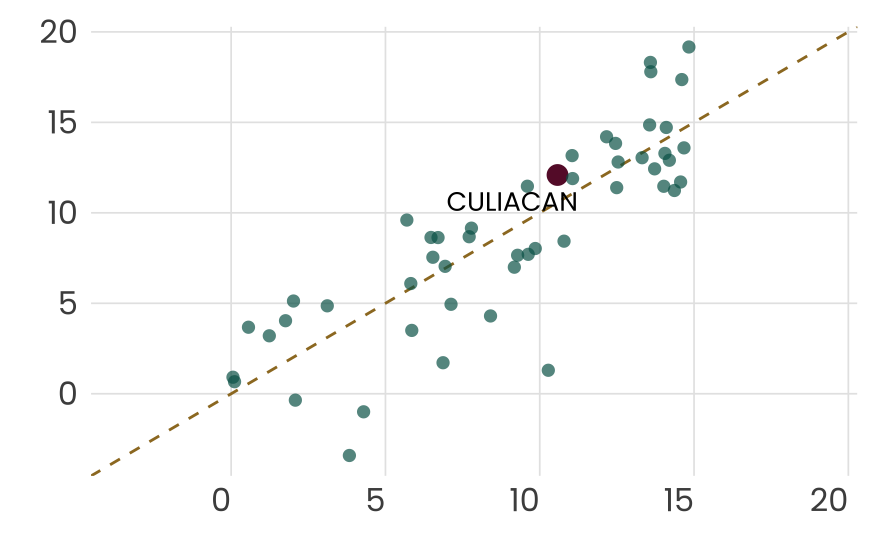
# Clasificación solo para Culiacán
sim_mun <- sim_mun %>%
mutate(
is_culiacan = cve_municipio == "CULIACAN",
color_cat = ifelse(is_culiacan, "Culiacán", "Normal"),
alpha_cat = ifelse(is_culiacan, 1, 0.7),
size_cat = ifelse(is_culiacan, 3.5, 2)
)
# Límites
lim_min <- min(sim_mun$promedio_diario_2023_2024, sim_mun$promedio_diario_2024_2025)
lim_max <- max(sim_mun$promedio_diario_2023_2024, sim_mun$promedio_diario_2024_2025)
# Colores
colores <- c(
"Culiacán" = "#671435",
"Normal" = "#006157"
)
# Gráfica
graf5 <- ggplot(sim_mun, aes(x = promedio_diario_2023_2024, y = promedio_diario_2024_2025)) +
geom_abline(slope = 1, intercept = 0, color = "#9D792A", linetype = "dashed") +
geom_point(aes(color = color_cat, alpha = alpha_cat, size = size_cat), shape = 16) +
geom_vline(xintercept = 0, color = "gray30", linewidth = 0.4) +
geom_hline(yintercept = 0, color = "gray30", linewidth = 0.4) +
geom_text_repel(
data = sim_mun %>% filter(is_culiacan), # Solo etiqueta a Culiacán
aes(label = cve_municipio),
family = "Poppins", fontface = "bold", size = 3.5,
box.padding = 0.4, max.overlaps = 10
) +
scale_color_manual(values = colores) +
scale_alpha_identity() +
scale_size_identity() +
scale_x_continuous(limits = c(lim_min, lim_max), labels = comma_format()) +
scale_y_continuous(limits = c(lim_min, lim_max), labels = comma_format()) +
tema_estilo_multilinea() +
theme(
legend.position = "none",
plot.margin = margin(10, 10, 10, 10),
axis.text.x = element_text(angle = 0, vjust = 1, hjust = 1)
)
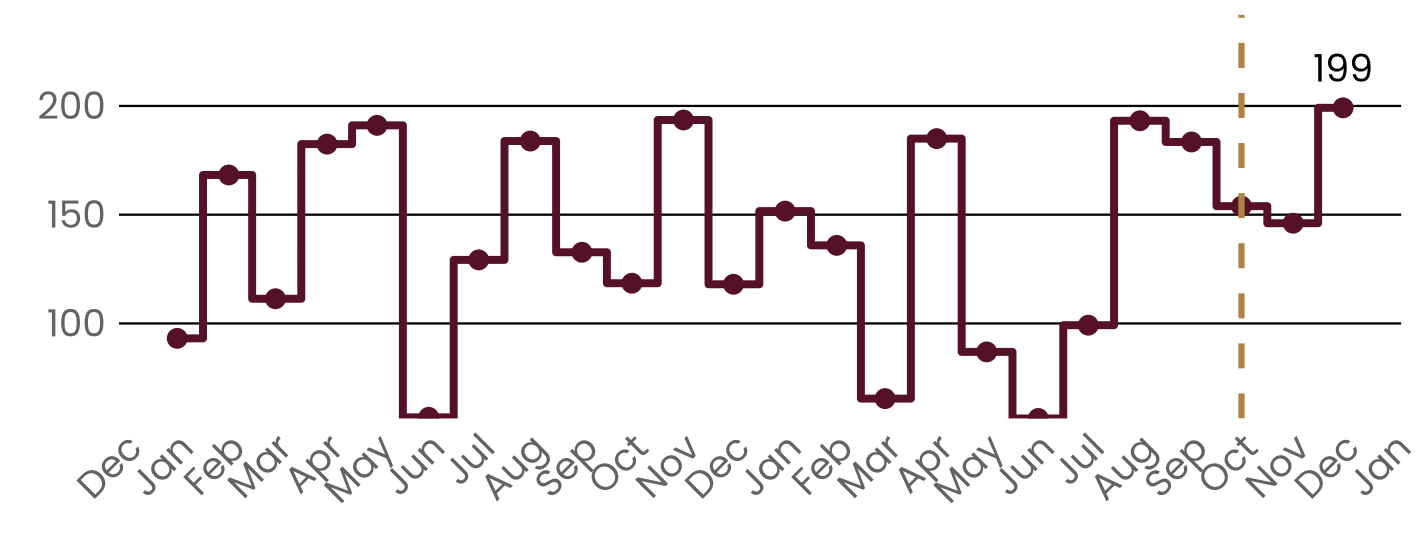
# Fuente y estilo
font_add("Poppins", "/Users/tabatagarcia/Desktop/plantillas/python/agrupadasyapiladas/fonts/poppins/Poppins-Regular.ttf")
showtext_auto()
# Tema limpio tipo matplotlib
tema_python_atdt_2 <- function() {
theme_minimal(base_family = "Poppins") +
theme(
plot.title = element_text(size = 20, face = "bold", color = "black"),
axis.text = element_text(size = 14, color = "#767676"),
axis.title = element_blank(),
panel.grid.major.x = element_blank(),
panel.grid.minor = element_blank(),
panel.grid.major.y = element_line(color = "#000000", linewidth = 0.4),
axis.ticks = element_blank(),
plot.background = element_rect(fill = "transparent", color = NA),
panel.background = element_rect(fill = "transparent", color = NA)
)
}
ggplot(df, aes(x = Fecha, y = y)) +
geom_step(color = "#691c32", linewidth = 1.4, direction = "mid") +
geom_point(color = "#691c32", size = 3) +
geom_vline(xintercept = 0, color = "gray30", linewidth = 0.4) + # línea eje Y
geom_hline(yintercept = 0, color = "gray30", linewidth = 0.4) + # línea eje X
geom_vline(xintercept = as.Date("2024-10-01"), color = "#BC955C",
linetype = "dashed", linewidth = 1.1) +
geom_text(
data = ultimo_punto,
aes(label = scales::comma(y)),
vjust = -1,
fontface = "bold",
size = 5,
family = "Poppins"
) +
scale_y_continuous(labels = comma_format(),
expand = expansion(mult = c(0, 0.3))) +
scale_x_date(date_breaks = "1 month", date_labels = "%b") +
tema_python_atdt_2() +
theme(
axis.text.x = element_text(angle = 45, hjust = 1)
)
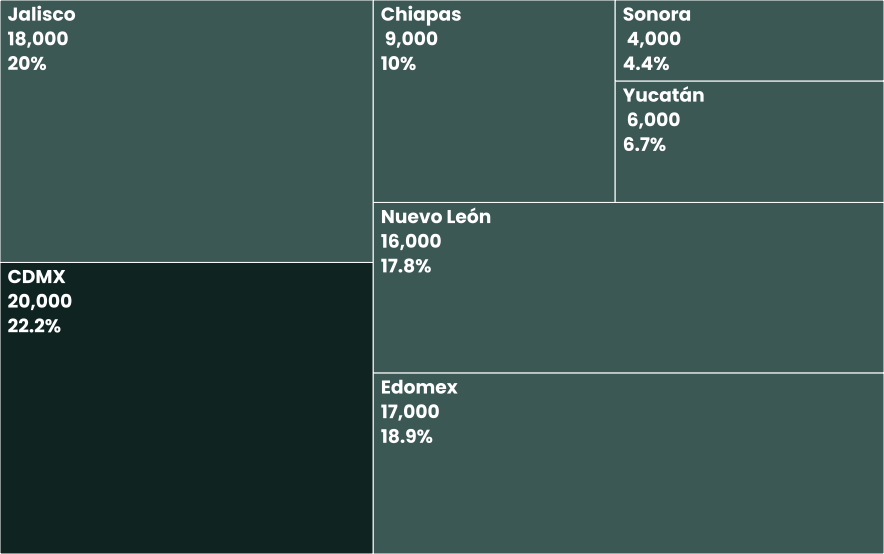
# Fuente
font_add_google("Poppins", "Poppins")
showtext_auto()
# Colores
verde_oscuro <- "#10302C"
verde_claro <- "#4C6A67"
data <- data %>%
mutate(
color = ifelse(total == max(total), verde_oscuro, verde_claro)
)
# Treemap
ggplot(data, aes(area = total, fill = color, label = etiqueta)) +
geom_treemap(color = "white", linewidth = 3) +
geom_treemap_text(
family = "Poppins", fontface = "bold", colour = "white",
place = "topleft", grow = FALSE, reflow = TRUE,
lineheight = 1.1, size = 7
) +
scale_fill_identity() +
theme_void()